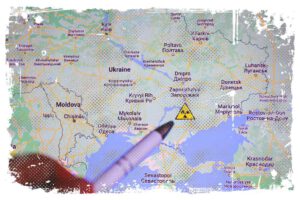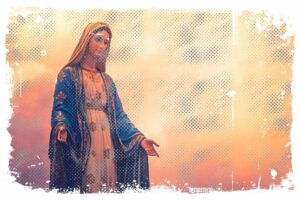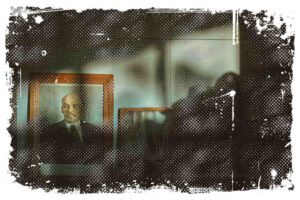This article was based on research, but primarily on an interview I read with professor Jan Żaryn. Historian and authority specializing in World War II.

When World War II broke out, the Polish Catholic Church found itself in a difficult position. During the occupation, the Roman Catholic Church faced the most repression because most Poles were Roman Catholics. But it wasn’t just the Catholics who were affected, all religious groups were targeted by the Germans and Soviets. The church faced the worst destruction as it was the first and most significant target due to the anti-Polish nature of the occupation.
The Church Was Seen as Synonymous with Polishness
According to Professor Jan Żaryn, the Roman Catholic Church played a major role in resistance against German occupiers in Polish lands during the 19th century. The Germans viewed the Church as synonymous with Polish identity and therefore targeted it during their occupation in the fall of 1939. They sought to eliminate Polishness by destroying the church, using more advanced technology than in the past, and implementing a genocidal policy. The Church was also seen as a cultural symbol of resistance, specifically through defending specific shrines that helped to preserve Polish identity.
Repression in Lands Incorporated into the Reich
Repression against Catholicism was particularly severe in areas that were directly incorporated into the Third Reich, such as Greater Poland, Pomerania, and the Lodz district. The number of murdered priests was staggering. In the Diocese of Wloclawek, 49% of the clergy were killed, in Chelmno 48%, in Lodz almost 37%, and in Poznan 31%.
↳ PRO TIP: Do you like traveling? Then before you buy any ticket or book an attraction, check if it's available in this worldwide Viator Database. You may save a lot of money and time. No need to thank me :)
In Polish Pomerania, out of 690 priests, the National Socialists arrested 460 priests. 214 of them were murdered, including all members of the Pelplin Cathedral Chapter. The remaining priests were exiled to the General Government. By 1940, there were only 20 priests left ministering in Pomerania.
Attempt to Remove Catholic Identity
The occupying German army’s decision to blow up the statue of the Sacred Heart of Jesus in Poznań in 1939 was an early indication of their anti-Christian policy. Hitler’s Governor of the Wartheland, Artur Greiser, was a particularly zealous executor of this policy. Under his orders, about 1,300 Catholic churches and chapels were closed between 1939 and 1944, and around 500 of them, including the Poznań cathedral, were converted into warehouses.
The Gestapo deported 1,092 Polish priests from Greater Poland to concentration camps and prisons. 662 of them never returned home, and were killed in Nazi executioneries. Greiser’s goal was to not only remove the Polish character from Wielkopolska but also all traces of its Catholic identity. This was reflected in his ordinance to remove roadside crosses and shrines, which were common in the Wielkopolska countryside
The Church as an Enemy of The Nazis
The cross was a symbol of resistance against the swastika, and the Polish Church was heavily persecuted by the Nazis not only in areas that were incorporated into Germany but also in other territories. In the Warsaw diocese alone, the National Socialists murdered 212 Catholic priests.
They also targeted the Polish clergy in the eastern territories of the Republic, like on July 31, 1943, when the Gestapo arrested 11 nuns from the Congregation of the Holy Family of Nazareth in Novogrudok and executed them the following day. Today, these nuns are considered martyrs for the faith.
Priests Extermination In Dachau
The Dachau concentration camp was a death camp specifically „designed” to exterminate Catholic priests, not only from Poland, but from 24 nations around the world. Over 2,500 priests were held there during World War II.
Dutch priest DeConnick, who was an inmate of Dachau, described the prison supervisors as filled with true hatred, with eyes burning with meanness, lips twisted in anger at the mere sight of a priest.
Victims of Medical Experiments
The Third Reich authorities allowed the construction of a chapel in the camp where imprisoned priests could celebrate mass. The first mass in Dachau was celebrated on January 22, 1941, by a Polish priest, Father Pawel Prabucki, who died a year later from exhaustion. After the mass was completed, all the priest-prisoners gathered in the chapel and recited „Christus vincit!” However, some of them were also victims of medical experiments.
A full account of the persecution and martyrdom of Catholic clergy imprisoned in Dachau would fill many volumes. One example is the transport of 530 Polish priests, many of them elderly, who arrived at the camp on October 29, 1941, of whom only eight survived the winter.
Some of them were selected for barbaric „medical experiments” by Heinrich Himmler himself during his visit to Dachau in 1942. Another 120 priests met the same fate. The head of the Nazi occupation administration in the General Government, Hans Frank, noted that the Catholic clergy were our mortal enemies, and that the Church was seen as a central rallying point for Polish minds, and a necessity of life.
He also stated that the Church remained the last center of Polish nationalism. He also knew that the Church was radiating constantly in silence, fulfilling the function of eternal light and that even if all the lights for Poland went out, there was always the Saint of Czestochowa and the Church.
I believe you may be also interested in my other article, from which you will learn about the role of church and catholicism in Poland after the War.
Did the Vatican Make any Attempts to Counter the Actions of the Nazi-Germans?
According to Professor Jan Żaryn, the Vatican attempted, through the Apostolic Nuncio in Berlin, Cesare Orseniga, to allow the Roman Catholic Church to continue operations in the area. However, these negotiations were met with resistance from the Polish government-in-exile, which was monitoring the situation through its ambassador to the Vatican, Casimir Papé.
The Vatican found itself in a tricky spot, as it was facing pressure from both the Germans, who wanted Catholicism in the territory to be German, and the Poles, who wanted to uphold the 1925 Concordat.
It’s worth noting that Arthur Karl Greiser, the governor of the Land of Warta appointed by Hitler, was given the task of carrying out the „atheization” of the area. The State of Wartheland was intended to be a test case for the eventual eradication of the Catholic Church throughout the Third Reich.
Did Church Take Part in Providing Aid to Jews?
According to Professor Jan Żaryn, the Church was actively involved in providing aid to Jews during the occupation. One way in which priests helped was by falsifying records in order to provide Jews in hiding with false identities. This was particularly important for Jews who could pass as „Aryans” and needed fake documents (ID) to live „on the surface”.As of 1942, this assistance was primarily aimed at Jews.
The Polish Catholic Church played a significant role in rescuing Jews. Many religious congregations, particularly those run by women, hid Jewish children and adults in their houses. Sister Matylda Getter from Warsaw and Irena Sendler were among those who helped arrange for Jewish children and adults to be placed with Catholic families in the area. Some of the Franciscan Sisters of the Cross in Laski were of Jewish origin, and they continued to live there while they helped others.
Situation of the Catholic Church Under Soviet Occupation
According to Professor Jan Żaryn, there were two phases of Soviet repression of the church during the occupation: 1939-1941 and 1944-1945. During the first phase, the clergy was not targeted as harshly as other groups, such as the landed gentry or Polish civil servants. The Soviets adopted a more flexible approach toward churchmen. This was due to the fact that they had different methods of depolonization and atheization than the Germans.
When the Soviet Union annexed the Eastern Borderlands of the Second Polish Republic, they immediately enforced a law that had been in place since 1918 called the Decree on the Separation of State and Church. This law led to the instant confiscation of all church property and the elimination of all Catholic Church structures, including religious congregations.
While priests were still allowed to remain within their diocese or parish, these institutions were no longer officially recognized by the Soviet government. Atheization was carried out by limiting the activity of existing religious congregations or priests, by taking away their material facilities, and most importantly, by prohibiting them from catechizing. The main tool of atheization became Soviet propaganda.
How many Polish Catholic Clergy Died During the War?
Approximately 2,000 Polish priests and religious figures died during the German occupation, according to Professor Jan Żaryn. This is more than 20% of the Catholic clergy before 1939.
Many of these deaths were a result of being a priest, or due to their solidarity with the nation fighting for freedom, such as priest chaplains during the Warsaw Uprising, or those who were part of partisan units or the Polish Armed Forces.
This loss is considered to be one of the most painful among other professions. The majority of priests who died during the war belonged to those archdioceses and dioceses whose lands were directly annexed to the Third Reich in 1939. This is the statistical dimension of the great sacrifice made by the Polish priests of the Roman Catholic Church as part of their vocation.
Bibliography:
- https://historia.org.pl/2016/09/29/kosciol-katolicki-w-polsce-w-pierwszych-miesiacach-po-ii-wojnie-swiatowej/
- https://dzieje.pl/wideo/prof-j-zaryn-kosciol-rzymskokatolicki-na-ziemiach-polskich-byl-przez-okupantow



